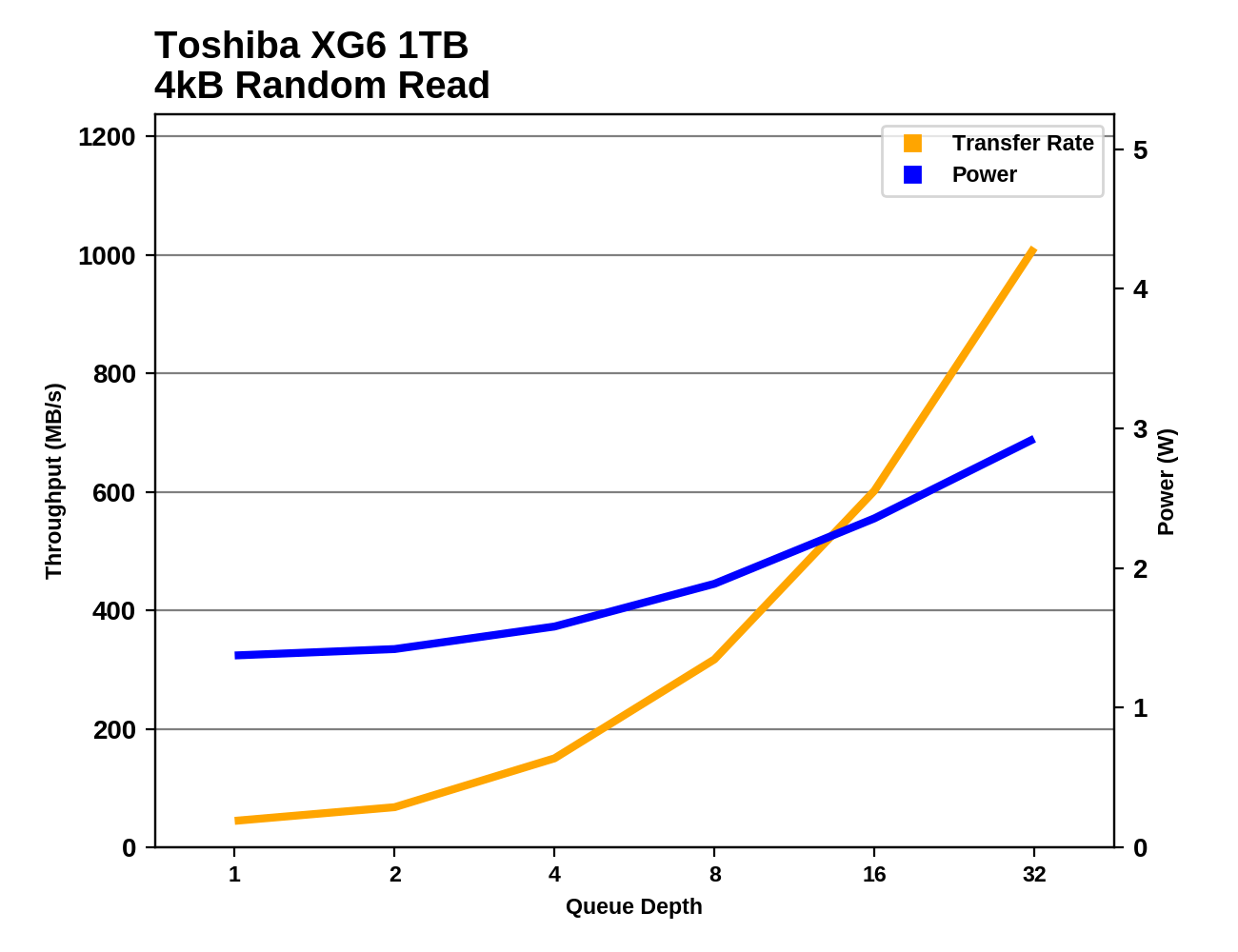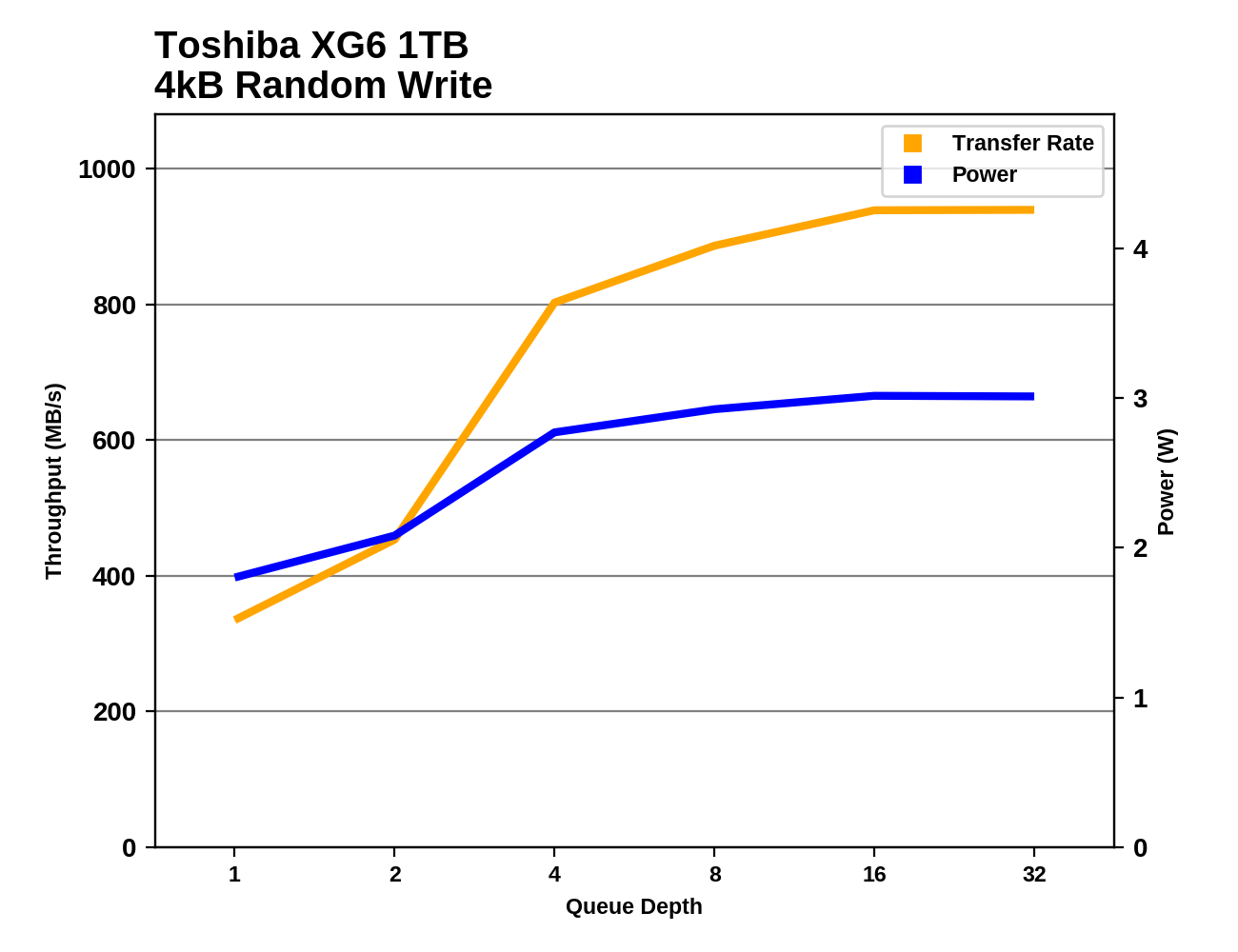The Toshiba XG6 1TB SSD Review: Our First 96-Layer 3D NAND SSD
by Billy Tallis on September 6, 2018 8:15 AM ESTRandom Read Performance
Our first test of random read performance uses very short bursts of operations issued one at a time with no queuing. The drives are given enough idle time between bursts to yield an overall duty cycle of 20%, so thermal throttling is impossible. Each burst consists of a total of 32MB of 4kB random reads, from a 16GB span of the disk. The total data read is 1GB.

The burst random read performance of the Toshiba XG5 was rather slow and the XG6 improves on it but not enough to bring it up to par. Intel/Micron 3D TLC seems to offer substantially lower read latency, though some other drives have managed to get better random read performance out of BiCS TLC than Toshiba's XG series.
Our sustained random read performance is similar to the random read test from our 2015 test suite: queue depths from 1 to 32 are tested, and the average performance and power efficiency across QD1, QD2 and QD4 are reported as the primary scores. Each queue depth is tested for one minute or 32GB of data transferred, whichever is shorter. After each queue depth is tested, the drive is given up to one minute to cool off so that the higher queue depths are unlikely to be affected by accumulated heat build-up. The individual read operations are again 4kB, and cover a 64GB span of the drive.

The rankings for sustained random read performance are largely similar to the burst random read test. The XG6 is improved over the XG5 but there's still quite a bit of room for improvement.
 |
|||||||||
| Power Efficiency in MB/s/W | Average Power in W | ||||||||
The XG6 puts Toshiba back into a tie for the best power efficiency from a TLC drive performing random reads, because the middle of the road performance doesn't require all that much power—just over half the power required by the SM2262EN's class-leading performance.
 |
|||||||||
While the low queue depth random read performance from the Toshiba XG6 is nothing special, it does scale up quite well and by QD32 it has caught up with the SM2262EN and pulled ahead of all other TLC drives.
Random Write Performance
Our test of random write burst performance is structured similarly to the random read burst test, but each burst is only 4MB and the total test length is 128MB. The 4kB random write operations are distributed over a 16GB span of the drive, and the operations are issued one at a time with no queuing.

The burst random write performance of the Toshiba XG6 is about 12% faster than the XG5—not enough to catch up to the fastest drives, but enough to stay above average even as the standards for high-end performance climb from year to year.
As with the sustained random read test, our sustained 4kB random write test runs for up to one minute or 32GB per queue depth, covering a 64GB span of the drive and giving the drive up to 1 minute of idle time between queue depths to allow for write caches to be flushed and for the drive to cool down.

On the longer random write test, the Toshiba XG6 places at the top of the second tier of drives. It can't match the very fastest competitors, but it beats all the more mid-range NVMe drives.
 |
|||||||||
| Power Efficiency in MB/s/W | Average Power in W | ||||||||
The XG6 has leapfrogged the WD Black to retake the lead in power efficiency during random writes, with about a 7% performance per Watt lead. Even with the improved performance relative to the XG5, the XG6 is is still one of the least power-hungry NVMe drives during this test.
 |
|||||||||
The random write performance of the XG6 scales best from QD2 to QD4 which brings it near saturation. This pattern is similar to the behavior of drives from Samsung, WD and the XG5, while the Phison and Silicon Motion controllers seem to pick up the pace a bit earlier with better QD2 performance.










31 Comments
View All Comments
DanNeely - Friday, September 7, 2018 - link
As long as the tests are the same, you can always pull the comparisons up yourself in Bench.While I sympathize with wanting them in the article tables, 3 or 6 years of historical low/mid/high end SSDs would end up either eating a lot of the tables reducing the number of current drives listed or making them much longer, so I fully understand why very little of that data is in the main tables.
wumpus - Thursday, September 6, 2018 - link
DRAM buffer isn't mentioned but board has 4 chips on it, two are obviously flash chips, one is the Toshiba controller and one is by Nanya, a DRAM manufacturer. The kicker is that as an OEM part, the final customer has no way of telling if that chip is populated before purchase (and the lack of specs make it easier to leave it off).Hopefully if these make it to the open market we can at least tell if they have the DRAM or not. Note that some of the cheaper NVMes (think ADATA XPG 6000) seem to do fine without DRAM, but they are priced to compete with SATA, not other NVMes.
Billy Tallis - Thursday, September 6, 2018 - link
No XG6-based OEM drive is going to be DRAMless. Toshiba has the BG series for that purpose, with an entirely different controller.wumpus - Thursday, September 6, 2018 - link
Really? Then who took that photo? Is the board in the photo the board that you reviewed? That board clearly has this chip on it:http://www.nanya.com/en/Product/4228/NT6CL128M32CM...
That's a 4Gb (512MB) LPDDR3 DRAM chip. Don't tell me that the board in the photograph doesn't have DRAM. They might not ship DRAM with the OEM devices, but that doesn't mean they didn't give you a SSD with DRAM to review.
MrSpadge - Thursday, September 6, 2018 - link
He did not say"No, XG6-based OEM drive is going to be DRAMless",
just
"No XG6-based OEM drive is going to be DRAMless."
i.e. none of these drives will be DRAMless.
wumpus - Thursday, September 6, 2018 - link
My eyes are going. Should I go get a monitor with less dot pitch or get a mac where it doesn't force dot pitch to the monitor size? Decisions, decisions.Commas are just to small for modern monitors. I was planing on getting higher dot pitch, but now I'm wondering.
Valantar - Friday, September 7, 2018 - link
I doubt a different monitor would help if your eyes are inserting punctuation where there is none - missing it when it's there is another matter. Besides, the fact that the sentence with an inserted comma doesn't add up grammatically should have tipped you off.Walkeer - Thursday, September 6, 2018 - link
testing ssd performance on intel plaform is like testing race slicks tires on a child paddle car. Intel I/O performance went down by tens of percents with all the meltdown/spectre mitigations. please use AMD plaform insteadMrSpadge - Thursday, September 6, 2018 - link
Usually they keep testing environments consistent for 1-2 years exactly due to such changing software conditions. It could well be that the next test suite will feature AMD CPUs and, as always, yield results not strictly comparable to the older ones.29a - Thursday, September 6, 2018 - link
If that was the case they wouldn't use the spectre/md patches.